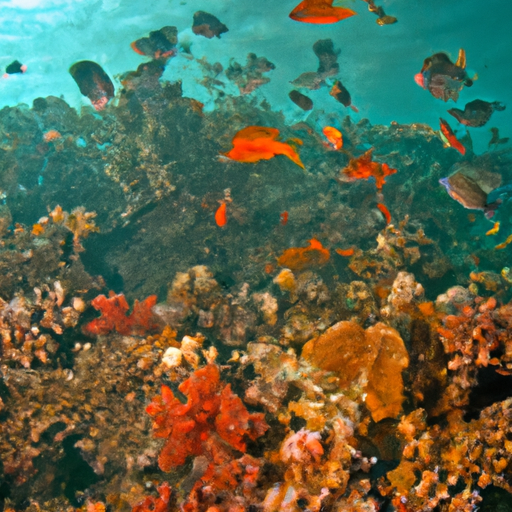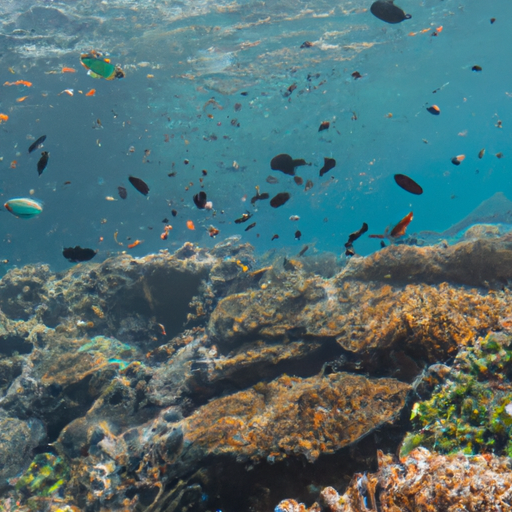
The Biodiversity of Coral Reefs: A Fascinating Haven for Marine Life
The underwater world is a breathtaking and colorful realm, teeming with an incredible diversity of marine life. Coral reefs, in particular, showcase the wonders of this underwater biodiversity. With their vibrant colors and intricate structures, coral reefs are not only visually stunning but also serve as vital ecosystems for countless species.
Exploring the biodiversity of coral reefs provides a fascinating glimpse into the sheer variety of marine life that calls these underwater havens home. From tiny, colorful fish darting between the coral branches to majestic sea turtles gracefully gliding through the water, the abundance of species is truly awe-inspiring.
One of the key attractions of coral reefs is the stunning array of colors that can be found among the marine life. Brilliantly colored fish such as the clownfish, with its vibrant orange body and striking white stripes, stand out against the backdrop of the reef. Magnificent corals themselves come in an array of hues, ranging from deep blues and purples to vibrant greens and pinks. Together, these colors create a mesmerizing underwater landscape.
But coral reefs are not just about beautiful colors. They also provide vital habitats and nurseries for a wide range of marine species. In fact, it is estimated that coral reefs support around 25% of all marine life, despite only covering less than 1% of the Earth’s surface. From small invertebrates to large predators, the interconnectedness of species within coral reef ecosystems is crucial for their survival.
Furthermore, coral reefs contribute to the overall health of our planet by acting as natural barriers against storms, reducing coastal erosion, and supporting local economies through tourism and fishing industries. Additionally, they play a significant role in carbon storage, helping to mitigate the impacts of climate change.
It is essential to protect and preserve these delicate ecosystems to ensure the continued existence of the remarkable marine life they harbor. Through sustainable practices such as responsible tourism, fishing regulations, and marine protected areas, we can safeguard these ecosystems for future generations.
The biodiversity of coral reefs is a testament to the resilience and beauty of marine life. Exploring these underwater wonders not only offers a glimpse into the intricacies of nature but also fosters a deep appreciation for the importance of preserving these remarkable ecosystems for generations to come.
Discovering the Enigmatic Creatures of the Deep Sea
The deep sea is a mysterious and enchanting realm that holds countless wonders waiting to be discovered. Exploring the colorful underwater world of marine life is a captivating adventure that unveils the intricacies of some of the most enigmatic creatures on our planet.
As we delve into the depths of the ocean, we encounter an astonishing array of vibrant colors that adorn the creatures that call these depths home. The vibrant hues are not just visually stunning but also serve various purposes in the underwater ecosystem.
Some deep-sea organisms sport bright colors as a form of warning, indicating to potential predators that they are toxic or dangerous. Others use their vivid pigments as a means of camouflage, blending seamlessly with their surroundings to avoid detection. These adaptive strategies are a testament to the incredible diversity and sophistication of life in the deep sea.
One such example of the mesmerizing colors found in the deep sea is the bioluminescence exhibited by many marine organisms. Some creatures possess the ability to produce their own light through biochemical reactions, resulting in a stunning display of fluorescent colors. These mesmerizing light shows serve multiple purposes, including communication, attracting prey, and even luring mates.
Not only are the colors of marine life intriguing, but the shapes and forms of these creatures are equally captivating. From elaborate, delicate corals that resemble underwater gardens to bizarre deep-sea fish with their unusual body structures, there is no shortage of awe-inspiring sights to behold.
The deep sea also harbors some of the oldest known species on Earth, with some organisms dating back millions of years. These ancient creatures offer a glimpse into the evolution and history of our planet, providing invaluable insights into the ecological and geological changes that have occurred over time.
Exploring the wonders of marine life in the deep sea requires advanced technology and specialized equipment. Researchers and scientists employ remotely operated vehicles (ROVs) and manned submarines to venture into these uncharted depths. Through their explorations, they bring back astonishing footage and samples that allow us to better understand and appreciate the beauty and diversity of the deep-sea ecosystem.
With each expedition into the deep sea, we uncover new species, unravel biological mysteries, and gain a deeper appreciation for the immense wonders that lie beneath the waves. As we continue to explore the colorful underwater world of marine life, there is no doubt that the enigmatic creatures of the deep sea will continue to captivate our imaginations and fuel our curiosity for years to come.
Unraveling the Beauty of Underwater Caves: A Hidden Ecosystem
Exploring the wonders of marine life is an exhilarating experience that takes us into the colorful underwater world. One of the most fascinating aspects of this underwater world is the presence of underwater caves, which provide a unique ecosystem for diverse marine life forms to thrive. These caves, hidden beneath the ocean’s surface, offer a captivating and mysterious environment for divers and marine biologists alike to delve into.
The underwater caves are formed through a long process of erosion, usually resulting from rising and falling sea levels and the dissolution of soluble rock formations such as limestone. Over time, these cave systems develop intricate passageways, chambers, and even stunning stalactites and stalagmites. As divers venture into these caves, they are immersed in a breathtaking world of natural beauty and aquatic life.
One of the most striking features of these underwater caves is the abundance of vibrant colors that adorn the walls and ceilings. The translucent waters allow the sunlight to filter through, casting an ethereal glow on the surrounding rock formations. Algae, coral, and other marine organisms add their own kaleidoscope of hues, creating an alluring visual spectacle.
As divers explore the depths of these caves, they may encounter an array of marine creatures. From tiny, brightly colored fish darting between crevices to larger, more elusive species seeking refuge, there is always an element of surprise and wonder. Schools of fish, crustaceans, echinoderms, and even delicate seahorses can be found, each contributing to the rich biodiversity of this hidden ecosystem.
Underwater caves also offer a haven for unique and delicate coral formations. These beautiful structures, formed over hundreds of years, provide habitat and protection for various marine organisms. The vibrant coral polyps, branching out in intricate patterns, are a testament to the harmony and interdependence of marine life within these caves.
Exploring underwater caves is not only visually stunning but also scientifically valuable. These caves act as a natural laboratory for researchers and marine biologists to study the intricate relationships and adaptations of marine organisms. They provide a glimpse into the resilience and adaptability of life in extreme environments, giving scientists valuable insights into our planet’s biodiversity and the impacts of climate change.
Unraveling the beauty of underwater caves is a journey of discovery and appreciation for the wonders of the marine world. From the captivating colors to the diverse array of marine species, these hidden ecosystems offer a glimpse into a world that is both awe-inspiring and fragile. As more people embrace the importance of protecting our oceans, the exploration and preservation of underwater caves become crucial to safeguarding the delicate balance of marine life.
Protecting Marine Life: The Importance of Conservation Efforts
Exploring the wonders of marine life is like diving into a magical, colorful underwater world. The diversity and beauty found beneath the ocean’s surface are truly remarkable. From vibrant coral reefs to mesmerizing schools of tropical fish, there is an abundance of life that captivates and inspires.
But this breathtaking world is under threat. The challenges facing marine life today, such as habitat destruction, overfishing, and pollution, necessitate the urgent need for conservation efforts. Protecting marine life is not only crucial for preserving the natural balance of our oceans but also for sustaining the delicate ecosystems that depend on them.
Coral reefs, often referred to as the “rainforests of the sea,” are home to an astonishing array of marine wildlife. These intricate ecosystems support a vast number of species, including colorful fish, sea turtles, and even sharks. Sadly, coral reefs face multiple threats, including bleaching caused by rising sea temperatures and ocean acidification. Conservation efforts are essential in preserving these delicate habitats and the countless species that rely on them for survival.
Additionally, marine protected areas (MPAs) play a significant role in safeguarding marine life. These designated areas provide a safe haven for a range of species, allowing them to flourish without the pressures of human activities. MPAs not only protect critical habitats but also support vital breeding and feeding grounds, ensuring the long-term survival of various marine species.
But conservation efforts extend beyond the boundaries of MPAs. Adopting sustainable fishing practices can help mitigate the impact of overfishing on marine life. By implementing and enforcing regulations, such as catch limits and gear restrictions, we can ensure the preservation of fish stocks and the overall health of our oceans.
Furthermore, reducing pollution, particularly plastic waste, is essential for the well-being of marine life. Millions of tons of plastic end up in the ocean every year, posing a significant threat to marine species. By embracing plastic alternatives, recycling, and promoting responsible waste management, we can reduce our impact on marine ecosystems and protect the creatures that call them home.
In conclusion, exploring the wonders of marine life is a truly awe-inspiring experience. However, it is our responsibility to ensure that future generations can share in this joy. Through conservation efforts, we can protect the vibrant and diverse underwater world, allowing marine life to thrive for years to come.


